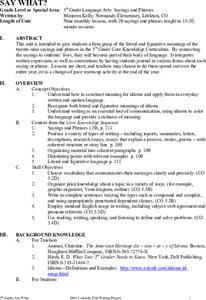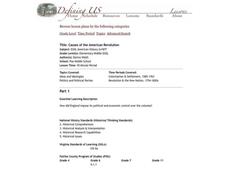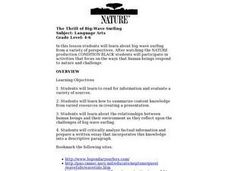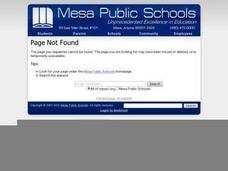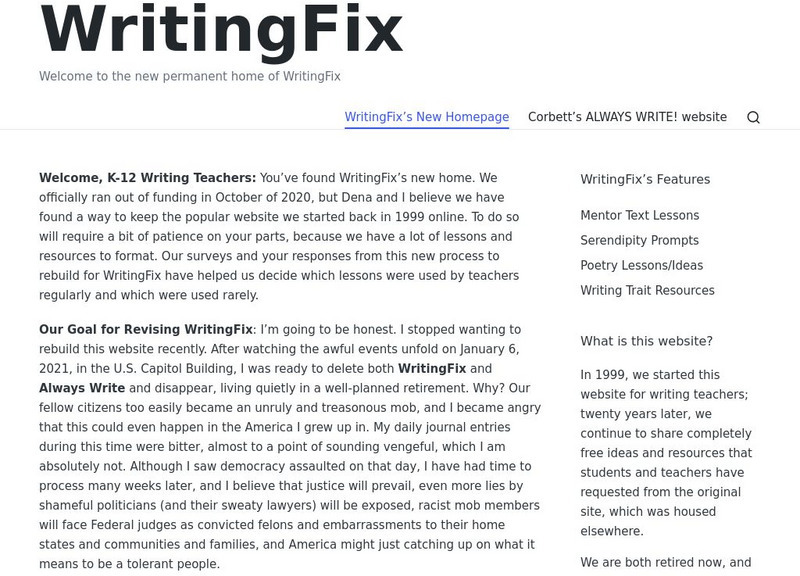Curated OER
Cultural Exchange
Students are introduced to the concept of cultural exchange and identify two examples of the concept. Individually, they research two specific examples of exchange and write about how it affected the two groups involved. They identify...
Curated OER
Say What?
Students explore the literal and figurative meanings of twenty-nine phrases and sayings. This unit of nine lessons integrates written expression and convention to demonstrate the value of idioms to the language.
Curated OER
A Cell Is Like A City
Students create analogies that help them remember the cell parts as well as their respective functions.
Curated OER
Underground Rails: The New York City Subway System
Students explore the New York Subway system. They investigate its usefulness as mode of transportation for the people in the city and study its history compared to other city subway systems. They examine how the subway connects the...
Curated OER
Transformations
Students identify the types of transformations in their lives. As a class, they determine the ones they have control over and which ones they do not. They practice solving problems in math and oral communication that they are faced with...
Curated OER
Is Congress for Sale?
High schoolers research web sites to measure the level of influence campaign donations and Political Action Committees have on their representatives and senators. They discover opportunities for private citizens to lobby elected...
Curated OER
Causes of the American Revolution
Students answer the question of: How did England impose its political and economic control over the colonies? They create a comic strip depicting the event of the Boston Massacre. Students complete a Wordstoming activity to anticipate...
Curated OER
Constitution Cartoons
Young scholars view series of cartoon overheads that explain Constitution, name branches of government and their powers, define federalism and separation of powers, examine rights and obligations of citizens, and discuss significance of...
Curated OER
Coming to America
Students read one book together about the immigrant experience. Teacher asks students to identify some of the themes around immigration contained in the book (example: prejudice).
Curated OER
The Link With TV and Vegetables
Fourth graders explore Philo Farnsworth, a fourteen year old farm boy in 1921, who thought up the idea of television. By the time he was in a high school physics class he drew his concept.
Curated OER
Upside-Down Books
Students read various examples of literature. In groups, they brainstorm a list of views that go against what was in one of the stories. They illustrate the opposite ideas and compile them into a class book. They use each other to...
Curated OER
Transportation and Communication Timeline
Students discuss the growth of transportation and communication technology since 1500 C.E. Individually or in groups, they research lists of developments in the two areas. Finally, students create timelines indicating the development...
Curated OER
The Thrill of Big-Wave Surfing
Students view a PBS Nature program about big-wave surfing and participate in a class discussion about their experiences with surfing, body boarding, or body surfing. Students create a drawing based on a reading and post their art around...
Curated OER
Publishing: A Persuasive Essay
Third graders are given an opportunity to create a visual to accompany their presentations of their persuasive essays. They may use the computer or other media as resources.
Curated OER
Historical Fiction - Based on facts or purely fiction?
Young scholars, after reading an Accelerated Reader historical fiction book, research the actual historical time period portrayed in the book. Then, working in a cooperative learning group, they create a HyperStudio presentation.
Curated OER
Lewis and Clark Encounters with Native Americans
Students research what the exchange was between the various Native American groups and Lewis and Clark. They are able to write reflections after truly considering the issue with the help of research.
Curated OER
Jints and Hannah
Students examine the relationship between slave owners and slaves. After viewing a photograph with her owner, students discuss the action of the photo and what it may or may not signify about their relationship. They read various...
CK-12 Foundation
Ck 12: 1.1: Descriptive Essays
[Free Registration/Login may be required to access all resource tools.] Learn everything you need to know about writing a descriptive essay including: using language that appeals to the five senses; understanding the difference between...
Daily Teaching Tools
Daily Teaching Tools: Free Graphic Organizers for Planning and Writing
This Daily Teaching Tools resource provides graphic organizers that students can use to plan their written pieces. Graphic organizers for all modes of writing are provided.
Other
Gallaudet University: English Works: Guide to Different Types of Essays
English Works site has suggestions on how to write an essay to convey helpful information. This site offers examples of eight different types of essays and graphic organizers.
Writing Fix
Writing Fix: Writing Fix Homepage
Have you ever needed someone to help you out with your writing? This site offers help to students and teachers. The lessons and resources are organized based on the 6 Writing Traits model. An especially interesting feature of the site is...
Khan Academy
Khan Academy: Courbet, the Stonebreakers
"The Stonebreakers" by Gustave Courbet seems to lack the basics of art (things like a composition that selects and organizes, aerial perspective and finish) and as a result, it feels more "real". View a picture and read a description in...



